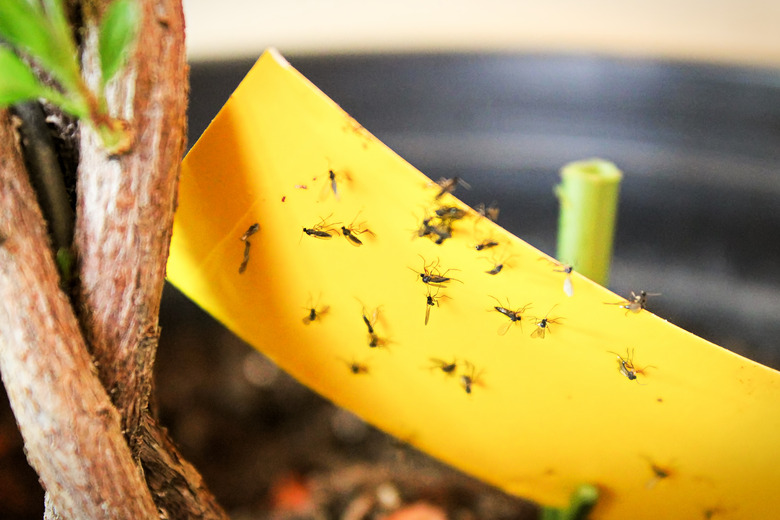How To Make A DIY Sticky Trap
We may receive a commission on purchases made from links.
When bugs invade your home, plants, and garden, there are a variety of commercially prepared products available to trap the critters. If you prefer nontoxic methods of elimination, DIY sticky traps are one way to trap bugs and evaluate the situation before proceeding to bug sprays and exterminators. Whether catching the insects fluttering around your plants or trapping the yellowjackets invading your cookout, there's a DIY trap to help you manage those unwanted visitors.
Sticky Traps for Plants
Sticky Traps for Plants
Many plant pests are attracted to the color yellow, though thrips are attracted to blue. Yellow cards covered with a sticky substance and hung from the plant are an effective way to attract and trap aphids, fungus gnats, and whiteflies:
- Coat both sides of a 3 x 5-inch yellow index card with a spray or brush-on product, like Tanglefoot Tangle-Trap Sticky Coating, or use double-stick clear tape.
- Punch a hole in one corner for a loop of twine.
- Hang one or more DIY sticky traps on or near the plant.
Alternatively, a yellow pan filled with salt water or apple cider vinegar mixed with a drop or two of dishwashing liquid can be used to attract a variety of flying pests, like winged aphids and fruit flies:
- Simply spray-paint a recycled pie pan or plastic container with yellow paint formulated for metal or plastic, such as Krylon Fusion spray paint.
- Allow the paint to dry completely.
- Place the pan near your plants and then fill it with salt water. Keep it out of the reach of children and pets.
DIY Glue Trap for Bugs
DIY Glue Trap for Bugs
Crawling bugs, such as cockroaches and silverfish, may be trapped by DIY glue traps or sticky traps. Use a 4 x 6-inch index card, paperboard, or cardboard and spray or brush Tanglefoot on one side to make a gluey sticky trap. You can also use double-sided tape or wrap the cardboard with duct tape sticky side up to catch the creepy-crawlies.
Put an attractant in the center of your trap. A bit of peanut butter will attract roaches, which will get stuck to the trap. You can also mix equal parts peanut butter with boric acid and put it into a bottle cap. Set the cap in the middle of the sticky trap to eliminate possible escapees or place it behind and inside cabinets where children and pets cannot access the toxic bait.
Sticky Fly Traps
Sticky Fly Traps
Hang up fly ribbons to attract flies and other flying insects. Use thin strips of plastic, such as a cut-up grocery bag, and coat them with a sticky substance and/or a thinned solution of hot water and honey. Alternatively, use a long strip of clear, double-sided tape and dab a little honey or other attractant down the center of the tape. Attach a string at one end and a small fishing weight at the other and hang it where flies are a nuisance.
Wasp and Fly Bottle Traps
Wasp and Fly Bottle Traps
Wasps and flies are lured into traps by attractants like fermenting fruits and fruit juices, meats, beer or soda, and/or apple cider vinegar. Make a bottle trap with a recycled plastic bottle:
- Cut the bottle near the top and then turn the upper portion upside down to make a funnel leading to the interior.
- Tape or staple around the edges to hold it in place and add garden twine to hang the trap from the eaves or a nearby tree.
- Bait the trap with a commercial attractant or an overripe banana, fruit juice, beer, or apple cider vinegar to catch flies and wasps. Scraps of raw meat, bacon, and canned cat food attract bottle flies and yellowjackets.
- Add two or three drops of dishwashing soap to liquid baits so the trapped pests will drown.
